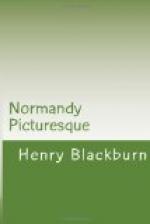The most striking thing about the tapestry is the charming freshness and naivete with which the scenes and characters are depicted. The artist who designed it did not draw figures particularly well, he was ignorant of perspective, and all principles of colouring; but he gave, in his own way, expression to his faces, and attitudes which tell their story even without the help of the latin inscriptions which accompany them. Shade is often represented by colour, and that not always strictly in accordance with nature; thus, a red horse will be represented with one leg worked in blue, and so on; the faces and naked limbs of the warriors being worked in green or yellow, or left white, apparently as was found most convenient by the ladies of the time.
Whether Queen Matilda, or the ladies of her court, ever really worked the tapestry (there is good reason to doubt that she designed the borders) is a question of so little importance, that it is wonderful so much discussion has been raised upon it; it is surely enough for us to know that it was worked soon after the Conquest. There is evidence of this, and also that Odo, Bishop of Bayeux (the Conqueror’s half-brother), ordered and arranged the work to the exact length of the walls of the church, round which it was intended that it should have been placed.
CHAPTER VI.
ST. LO—COUTANCES—GRANVILLE. (CHERBOURG.)
On our way to ST. LO, COUTANCES, and GRANVILLE on the western coast of Normandy, we may do well—if we are interested in the appliances of modern warfare, and would obtain any idea of the completeness and magnificence of the French Imperial Marine—to see something of CHERBOURG, situated near the bold headland of Cap de la Hague.
If we look about us as we approach the town, we shall see that the railway is cut through an extraordinary natural fortification of rocks; and if we ascend the heights of Le Roule, we shall obtain, what a Frenchman calls, a vue feerique du Cherbourg. We shall look down upon the magnificent harbour with its breakwater and surrounding forts, and see a fleet of iron-clads at anchor, surrounded by smaller vessels of all nations; gun-boats, turret-ships and every modern invention in the art of maritime war, but scarcely any ships of commerce. The whole energy and interest of a busy population seem concentrated at Cherbourg, either in constructing works of defence or engines of destruction.
The rather slovenly-looking orderly that we have sketched—sauntering up and down upon the ramparts, and sniffing the fresh breezes that come to him with a booming sound from the rocks of Querqueville that guard the west side of the bay—is justly proud of the efficiency and completeness which everywhere surround him, and with a twinkle in his eye, asks if ‘Monsieur’ has visited the arsenals, or has ever seen a naval review at Cherbourg. The pride and boast even of the boys that play upon these heights (boys with ‘La Gloire’ upon their hats, and dressed in a naval costume rather different from our notions of sailors), is that ‘Cherbourg is impregnable and France invincible,’ and, if we stay here long, we shall begin to believe both the one and the other.




